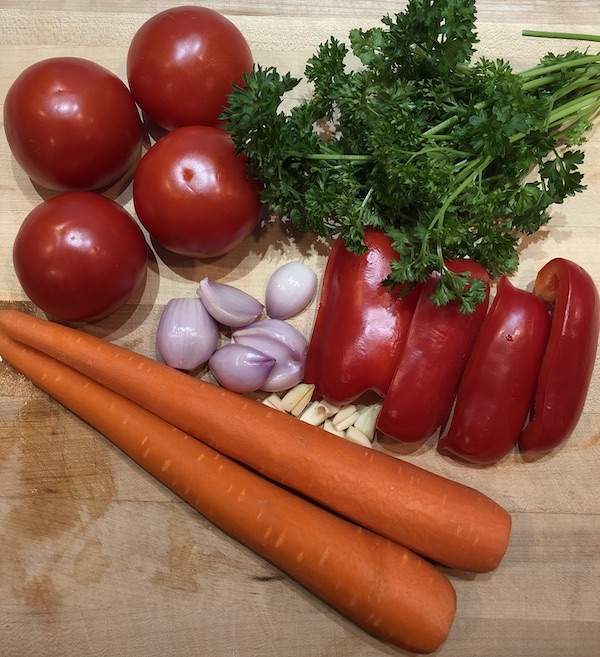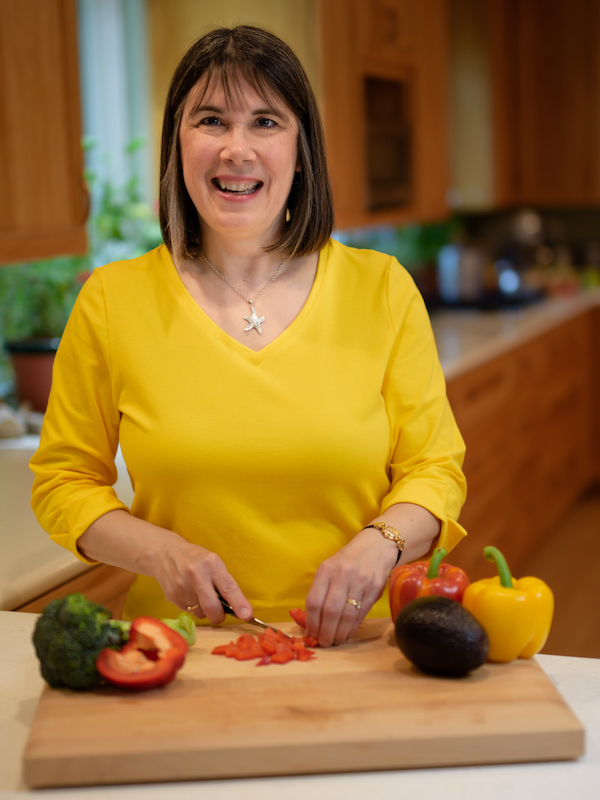
Cooking to Flourish: Meals Your Food Sensitive Family Enjoys
To schedule a free 15 minute consultation with Cindy about the biggest challenge cooking for your food sensitive family
Don’t miss an episode!
The button below will take you to Apple Podcasts to subscribe.
Or visit your favorite podcast provider to subscribe.
Thank you!
Resources and Links
Leann Birch https://en.wikipedia.org/wiki/Leann_Birch
Society of Sensory Professionals https://www.sensorysociety.org/knowledge/sspwiki/Pages/PROP%20and%20Taster%20Status.aspx
Eating Well, Retrain Your Taste Buds
http://www.eatingwell.com/article/9677/retrain-your-taste-buds/
(New research from the University of Buffalo)
Here is the transcript of the episode:
Welcome to the sensitive kitchen where home cooks are inspired to Cook to Enable Those You Love to Flourish.
I’m Cindy Sullivan, registered dietitian, passionate nutrition, educator, and accomplished home cook. Whether you’re changing, how you cook for food sensitivities, allergies, intolerances, or just trying to eat healthier on a budget. You’re in the right place. Most episodes, I will share favorite recipes as well as modification tips and nutrition benefits. Occasionally I’ll have a guest or special episode like modifying holiday favorites.
My favorite foods are raspberries and homemade chocolate chip cookies. My latest cooking project was long fermented sourdough bread.
Welcome to The Sensitive Kitchen where home cooks are inspired to Cook To Enable Those You Love to Flourish. I’m Cindy Sullivan, registered dietitian, passionate nutrition educator, and accomplished home cook.
Welcome to The Sensitive Kitchen. To start the new year, I am so excited to announce the very first class Food Sensitivity Kitchen is offering. It’s for you if you’re cooking for multiple food sensitivities and are looking for ways to make cooking dinner easier or taste better.
Whether you’re changing how you cook for food sensitivities, allergies, intolerances, or just trying to eat healthier on a budget, you’re in the right place. Most episodes, I will share favorite recipes as well as modification tips and nutrition benefits. Occasionally I’ll have a guest or special episode like modifying holiday favorites. My favorite foods? They’re raspberries and homemade chocolate chip cookies. My latest cooking project was long fermented sourdough bread.
If this is you, let me ask you one more question. Are you part of any group or program to help you create a personalized plan to get dinner on the table every night?
If this sounds interesting, I would love to talk to you about Cooking to Flourish: Meals Your Food-Sensitive Family Enjoys. Go to foodsensitivitykitchen.com/schedule to schedule a free 15 minute consultation with me this week in January, 2021.
Cooking to Flourish is an intimate cooking lab in your own kitchen. It’ll enable you to put delicious dinners on the table that your family enjoys. You know, because you’ve already tried the recipes with them in your own kitchen, so that they feel good after eating and ensure that you don’t spend all your time in the kitchen.
For more information, you can go to my website, foodsensitivitykitchen.com. Go to the Cooking to Flourish tab under under services. Or you can email me at [email protected].
In case you’re doing the dishes or walking or driving right now, the links will be in the show notes for this episode. Again, food sensitivitykitchen.com/012, which is this episode.
Now how many of you struggle to eat as many vegetables as you know are good for you, or maybe that are recommended?
Why?
We know vegetables are good for us. The one group of foods that almost everyone knows is good for them is vegetables. No matter what diet you’re following, no matter what meal plan is right for you, more vegetables are almost always recommended.
So why don’t we eat more vegetables? I could list for you several reasons, but the number one reason we eat or do not eat foods, at least over time, comes down to taste. I tell my community college students this, the number one reason people eat is taste.
I did a paper in grad school. I’ll tell you about in a little bit. Taste was critical for introducing new foods.
I did a recent survey and 41 people told me the number one reason or the number one thing they were looking for in their foods was taste.
We have an innate preference for sweet things, not so much for salty. So let’s talk about this issue of taste. And before we do, I’ll let you announce a little secret about vegetables.
I don’t eat very many leafy greens. Oh, I eat them raw. I enjoy them in salads, but cooked mustard greens, nope. Turnip greens or collard greens cooked not very often. And I’m a dietitian who knows how good vegetables are for you.
One of the good things about the pandemic was that I found an awesome recipe for eggs and greens from the talented chef and dietitian, Jeannie Petrucci that now we’ve incorporated into our regular dinner rotation. Hooray, we’re eating more greens and I’m even enjoying them.
But what if they still don’t taste good to us? If the number one reason we don’t eat vegetables is that they don’t taste good. Are we just all doomed?
Thankfully, the answer is no. Let’s talk today about how to change your taste buds, to eat more vegetables.
In other words, is taste nature or nurture? Can you change those taste buds?
As in many things in life, our environment influences our genes, both our environment and our genes influence how food tastes to us. Have you ever tried to increase your vegetable intake? Or if you have kids try to get them to eat more vegetables?
It can be a challenge even for adults, and kids have more taste buds that work better than older tastes buds. In other words, they taste things more intensely.
So can we change what tastes good to us? The answer that excites me and everyone who wants to eat healthier is yes.
Let’s start with the genetic part of this. Some of you are familiar with the concept of supertasters – the ability to taste PROP. It’s the name of the chemical 6-N-propylthiouracil, and PTC, which is phenylthiocarbamide is a genetically inherited trait. PROP determines whether we taste broccoli and related foods as bitter. About 30% of the population does not taste prop at all. These are the kids who happily consume all their veggies.
50% of the population tastes PROP moderately. This means that while they don’t love broccoli, it’s pretty easy for them to become accustomed to it.
20 To 25% of the population are supertasters. They not only taste bitter strongly, but they’re also more sensitive to sweet, salty and the burn of spicy hot. This is from the Society for Sensory Professionals.
Your kids may really not be making it up. That foods tastes different to them than they do to you. Or they may be holding out for a chocolate chip cookie instead of vegetables. Wouldn’t you, if you thought you could?
Knowing that we’re different is helpful at this point. Should we throw up our hands and give up? Not quite yet. This is where the ‘try it again’ mantra comes in. In our house, it was a two bite rule. You had to have two bites of everything on the table. Of course not if you were allergic or intolerant or sensitive to it.
Genes play a role in how we taste bitter food – PROP tasters, for example – but exposure is also important. Let’s look at this environmental component. Many years ago in grad school, I did a paper on how many exposures it takes for children to like a new food.
Leanne Birch did groundbreaking research in the 1970s and 80s. She found that it took at least 10 exposures for children to like a non-sweet food. Since breast milk is slightly sweet, we’re born with an innate preference for sweet foods.
And just as a side note, this preference does not exist for salty foods in newborn infants. In other words, salty foods are a learned preference. That’s good news for the half of Americans who need to reduce their sodium consumption. It means we can unlearn the preference for salty foods.
I don’t know if this has ever happened to you, but after we have reduced the sodium intake in my house, we went to certain restaurants or ate certain foods that we used to enjoy. And oh my word, were they salty. We can’t eat at certain restaurants anymore because everything is so salty. The preference for salt is learned, but the preference for sweet is not.
New research or newer research from the university of Buffalo has given us some clues as to why so many exposures to new foods are necessary. They do mostly research on rats, but they show us two important things.
First of all, what you eat affects the many proteins that exist in your saliva. In other words, the proteins in your saliva can actually be changed by what you eat. Why is this important?
To taste something you need to dissolve it in the saliva in your mouth. The proteins in the saliva modulate your sense of taste. That means over time, as you repeatedly eat a food, the proteins in your saliva change, which changes the taste of your food – almost like magic!
You can actually learn to like vegetables, but it takes repeated exposures, at least 10. Our sense of taste adjusts to what we eat repeatedly.
In addition to possible changes in saliva, what we eat with the vegetables can influence the acceptance of new foods. In a study published in the American journal of the Academy of Nutrition and Dietetics, researchers found that pairing a bitter vegetable – and they used Brussels sprouts – with the familiar food cream cheese increased liking that bitter food – Brussels sprouts – more than just the exposure.
But with a non-bitter vegetable – and they used cauliflower – repeated exposure was enough to increase. In other words, pairing a liked food like cream cheese with Brussels sprouts increases the liking of Brussels sprouts rather than just giving them Brussels sprouts over and over and over again.
This research was done with preschoolers, but before you dismiss it, what makes you think we’re really very much different when it comes to new foods? When my kids were young, we served a lot of dips with vegetables. I also made sure I also served a dish my kids liked the meal when we had winter squash.
Okay. Let’s talk about a few practical tips. How do we put these things into practice and perhaps learn to like vegetables?
Especially if you’re working with kids, the number one thing is model the behavior you want to see. Parents have told me, no, I don’t really like asparagus. My husband never eats asparagus, but my kids have to, Oh, trouble there. Right? So model the behavior you want to see.
Number two, think about something along the lines of everyone at the table takes two bites of every food. Maybe if you’ve got really little kids, maybe it’s just putting it in their mouth and chewing it. Maybe it’s whatever it is, you figure it out. Obviously this is not, this does not work if they’re sensitive, allergic, intolerant. Okay? But if not, consider having everybody take at least two bites of the food, after that, they decide how much they eat.
Number three is don’t give up, keep track of how many times a disliked vegetable is served. It may seem to you that it’s, you’ve been serving it forever, but it may have only been seven times, which is not enough to change tastes. And by the way, this is not 10 days in a row.
Your sense of taste is tied up with your sense of smell. Now, a couple applications to this one is perhaps foods might be better accepted if somebody has a slight cold and they’re a little bit congested. Secondly, many volatile compounds – meaning things you can smell, they’re things that are released – were bred out of some kinds of produce. Recently researchers are crossbreeding new varieties to increase the volatile compounds – the ones you smell that people find appealing. So they may be able to make a fruit or vegetable tastes sweeter without adding any sugar, for example. Be on the lookout for new varieties. And you may want to try new varieties of vegetables.
Prepare your vegetables well, don’t overcook them. Nobody likes slimy asparagus.
Try roasting, which often caramelizes the natural sugars, to increase palatability. Roasting doesn’t work for everything. But we found that we really like roasted broccoli a whole lot better than steamed broccoli. (Oops! I misspoke – we like roasted CAULIFLOWER better than steamed CAULIFLOWER!!) My daughter and I however like our steamed fresh green beans, better than roasted so, mileage may vary. Number five.
Oh, that was number five. Prepare your vegetables well. Number six is try roasting and
Number seven, add a small amount of salt or sugar, which masks the bitter flavor. Salt especially is really good at masking bitter flavor. Now those of you who are really restricting your sodium intake may not be able to do this, but most of you can add a little bit of salt, which masks bitter flavor, or a little bit of sugar. For example, a little bit drizzle of maple syrup on something.
Number right, add a flavorful ingredient like butter or cheese. You may be able to gradually decrease the amount of the butter or cheese once the food is accepted.
Number nine, don’t give up.
Guess what number 10 is? Don’t give up. Try again. It is okay to have a couple foods you don’t like. It’s okay for your kids to have a couple foods they don’t like. But maybe some of those foods you don’t like are because you haven’t eaten them enough. You haven’t tried them enough. You’ve just eaten them once and gone yuck. But maybe If you kept eating them, you may find vegetables that you like.
They’re good for you. They increase the variety in your diet. They give you all kinds of nutrients. You feel good after eating them, you get more fiber. Oh boy, I could go on and on and on. You reduce your risk of cancer and heart disease and all kinds of wonderful things from eating vegetables. But you gave up. You tried it once it was like ‘ick,’ you’re like, forget this. I’m never trying this again. That’s okay if it’s a food that’s not especially good for you.
But if it’s a food like a vegetable, Try it again. And again, and again. Change those saliva proteins Put some new nutrients into your diet, have fun with it. Figure out a way to make it a game for your kids.
I’m so glad you tuned in today. Let me remind you about Cooking to Flourish, which is my intimate “cooking lab in your own kitchen.” It’ll enable you to put delicious dinners on your table that your family enjoys so they feel good after eating and ensure that you don’t spend all day in the kitchen. If this sounds interesting, I’d love to talk to you about it.
If you’re listening to this in January, 2021, go to foodsensitivitykitchen.com/schedule to schedule a free 15 minute consult with me. There’s no obligation. I’d love to talk to you about feeding your food-sensitive family.
Thanks so much for listening. Keep Cooking to Enable Those You Love to Flourish and keep serving those vegetables. Have a great day. Bye-bye.




